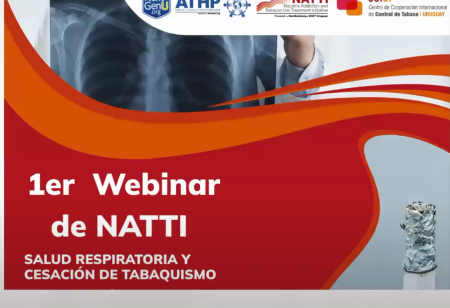

The Colors of Harm
A 2024 campaign was launched to raise awareness and inform the Uruguayan population about the health risks of Electronic Nicotine Delivery Systems (ENDS), known by various names such as electronic cigarettes, vapes, vaporizers, vaping devices, e-cigarettes, and others.
As organizations that promote the implementation of tobacco and nicotine control policies in Uruguay, we have decided to unite and carry out this joint campaign: the Pan American Health Organization, Ministry of Public Health of Uruguay, National Resources Fund, National Drug Board, Clínicas Hospital, Honorary Commission for the Fight Against Cancer, Honorary Commission for Cardiovascular Health, Uruguayan Society of Tobacology, Medical Federation of the Interior, National Administration of Power Plants and Electric Transmissions (UTE), Alliance for Non-Communicable Diseases, and the International Cooperation Center on Tobacco Control (ICCTC). The Publicis Impetu agency contributed with work to the creation and implementation of the campaign "LOS COLORES DEL DAÑO" (THE COLORS OF HARM) on an honorary basis.
The campaign will be carried out nationwide through social media and will last for three months starting on 31 May, 2024, which is World No-Tobacco Day -event organized by the World Health Organization (WHO)-. The focus will be on electronic cigarettes, as it has been identified that an increasing number of children, adolescents, young people, and adults are consuming these products, unaware of the extent of their multiple harms.
Follow the campaign on social media through Facebook, Instagram, and YouTube, using the tag #LosColoresdelDaño
From the WHO Framework Convention on Tobacco Control (WHO FCTC) Knowledge Hub on International Cooperation on Smoke-Free Environments and Tobacco Cessation, hosted at ICCTC, we consider this initiative important because there is evident deception and manipulation by manufacturers who claim that these products are supposedly harmless; presenting them with attractive flavors, colors, designs, and technology aligned with youth aesthetics.
Information about ENDS:
● Their use is addictive.
● Using e-cigarettes does not help to quit smoking.
● Vaping is prohibited in enclosed public spaces.
● Toxic and carcinogenic substances are emitted when vaping.
● E-cigarette waste increases environmental pollution
● Vaping has not been shown to be less harmful to health than smoking.
● It is proven that vaping increases the risk of acute heart attack, stroke, and acute and chronic lung disease.
The call is for continued commitment and collaboration among all organizations interested in population health, as this is a key time to effectively address the problem of vaping.
What scientific evidence tells us:
ENDS (Electronic Nicotine Delivery Systems), also called electronic cigarettes, have multiple popular names: vapes, vaporizers, e-cigarettes, or are directly known by their brand names (Juul, Vaporesso, Joyetech, Bali, Puff Bar, and thousands more).
Their popularity has dramatically increased in recent years, based on the false belief of their harmlessness and the diversity of flavors and colors of the devices, which play an important role in appealing to young people. A particular concern has been the increase in use by children, adolescents, and young adults, reversing decades of declining nicotine dependence in users of combustible tobacco (1).
ENDS heat and vaporize a liquid, whose basic ingredients are propylene glycol and vegetable glycerol, both of which are cellular toxicants. They also contain flavorings and other chemical compounds, among which toxicants and carcinogens have been detected; in general, they also contain nicotine, derived from nicotine salts that are added to the liquid. Their heating generates a whitish aerosol, which is glycerin vapor containing a large number of chemicals, including acetaldehyde, formaldehyde, and acrolein (herbicide). These toxicants contribute to cardiovascular disease and acute and chronic lung disease (2,3,4,5).
A national review by Llambí et al. on the subject concluded that there are short- and long-term health risks for ENDS consumers, as well as for those who passively inhale their emissions. Their use has not been shown to be an effective method to stop tobacco consumption and may perpetuate dual consumption of ENDS and combustible tobacco, thus maintaining nicotine addiction, as well as initiating consumption in young people and favoring relapse in ex-smokers (6).
As for their pulmonary effects, the use of ENDS in adolescents and adults was associated with increased airway reactivity, greater prevalence and exacerbation of asthma, higher incidence of respiratory diseases, and aggravation of symptoms in individuals with chronic obstructive pulmonary disease, as well as being a triggering factor for bronchiectasis (7).
There is substantial evidence that the use of ENDS produces oxidative stress and endothelial dysfunction, alterations closely related to the development of atherosclerosis and cardiovascular disease. Therefore, these individuals are more exposed to acute myocardial infarction and cerebrovascular disease (8).
A large number of smokers use combustible cigarettes and ENDS concomitantly. These "dual" users have been found to be at greater risk of developing cardiovascular disease than those who use only one type (9).
The WHO states that ENDS are especially dangerous for children and adolescents. Nicotine is a highly addictive substance, and the brain continues to
develop well past the age of 20. ENDS increase the risk of heart and lung disease, and are also risky for pregnant women, as they can harm the development of the fetus. There are concerns about the marketing of these products, whose dissemination includes false or misleading information about supposed health benefits and efficacy in helping to quit smoking (10).
Finally, it is worth remembering that in Uruguay, pursuant to the recommendations of the Conference of the Parties (COP) to the WHO FCTC, (11) to which the country is a signatory, the marketing and importation of ENDS is prohibited, as well as their use in enclosed spaces, and any form of advertising and promotion of these products.
References:
1. Wang TW, Neff LJ, Park-Lee E, et al.; E-cigarette Use Among Middle and High School Students — United States, 2020. MMWR Morb Mortal Wkly Rep 2020;69:1310–1312. Available at: https://www.cdc.gov/mmwr/volumes/69/wr/mm6937e1.htm?s_cid=mm6937e1_w [Consulted on: May 24, 2024].
2. Sassano MF, Davis ES, Keating JE, Zorn BT, Kochar TK, Wolfgang MC, et al.; (2018) Evaluation of e-liquid toxicity using an open-source high-throughput screening assay. PLoS Biol 16(3): e2003904. Available at: https://doi.org/10.1371/journal.pbio.2003904 [Consulted on: May 24, 2024].
3. Ogunwale MA, Li M, Ramakrishnam Raju MV, Chen Y, Nantz MH, Conklin DJ, Fu XA. Aldehyde Detection in Electronic Cigarette Aerosols. ACS Omega. 2017 Mar 31;2(3):1207-1214. doi: 10.1021/acsomega.6b00489. Epub 2017 Mar 29. PMID: 28393137; PMCID: PMC5377270. Available at: https://pubmed.ncbi.nlm.nih.gov/28393137/ [Consulted on: May 24, 2024].
4. Bein K, Leikauf GD. (2011) Acrolein - a pulmonary hazard. Mol Nutr Food Res 55(9):1342-60. doi: 10.1002/mnfr.201100279 Available at: https://pubmed.ncbi.nlm.nih.gov/21994168/ [Consulted on: May 24, 2024].
5. American Lung Association. El Efecto de los Cigarrillos Electrónicos sobre los Pulmones. Available at: https://www.lung.org/getmedia/fc9def70-dca4-4f7f-a947-d4465e4fbcd3/el-efecto-de-los-cigarrillos.pdf [Consulted on: May 24, 2024].
6. Llambí L, Rodríguez D, Parodi C, Soto E. Cigarrillo y otros sistemas electrónicos de liberación de nicotina: revisión de evidencias sobre un tema controversial. Rev Med Urug 2020; 36(1):59-73. Available at: http://www.scielo.edu.uy/scielo.php?pid=S1688-03902020000100153&script=sci_abstract [Consulted on: May 24, 2024].
7. Wold LE, Tarran R, Crotty Alexander LE, et al.; American Heart Association Council on Basic Cardiovascular Sciences; Council on Arteriosclerosis, Thrombosis and Vascular Biology; Council on Hypertension; and Stroke Council. Cardiopulmonary Consequences of Vaping in Adolescents: A Scientific Statement from the American Heart Association. Circ Res. 2022 Jul 22;131(3). Available at: https://www.ahajournals.org/doi/full/10.1161/RES.0000000000000544 [Consulted on: May 24, 2024].
8. U.S. Department of Health and Human Services. E-Cigarette Use Among Youth and Young Adults. A Report of the Surgeon General. Atlanta, GA: U.S. Department of Health and Human Services, Centers for Disease Control and Prevention, National Center for Chronic Disease Prevention and Health Promotion, Office on Smoking and Health, 2016. Available at: www.cdc.gov/tobacco/data_statistics/sgr/e-cigarettes/pdfs/2016_sgr_entire_report_5 08.pdf [Consulted on: May 24, 2024].
9. Osei AD, Mirbolouk M, Orimoloye OA, et al.; Association Between E-Cigarette Use and Cardiovascular Disease Among Never and Current Combustible-Cigarette Smokers. Am J Med. 2019
Aug;132(8):949-954.e2. doi:10.1016/j.amjmed.2019.02.016. Epub 2019 Mar 8. Available at: https://pubmed.ncbi.nlm.nih.gov/30853474/ [Consulted on: May 24, 2024].
10. Organización Mundial de la Salud. Tabaco: cigarrillos electrónicos. Preguntas y respuestas. January 19, 2024. Available at: https://www.who.int/es/news-room/questions-and-answers/item/tobacco-e-cigarettes [Consulted on: May 24, 2024].
11. Decision FCTC/COP7(9) Electronic nicotine delivery systems and electronic nonnicotine delivery systems, Conference of the Parties to the WHO Framework Convention on Tobacco Control, Seventh session. Available at: https://fctc.who.int/publications/m/item/fctc-cop7(9)-electronic-nicotine-delivery-systems-and-electronic-nonnicotine-delivery-systems




